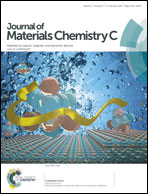Striking sensing improvement of n-type oxide nanowires by electronic sensitization based on work function difference†
Abstract
A novel approach to selectively improving the reducing or oxidizing gas-sensing abilities of n-type oxide nanowires (NWs), by modifying the conduction channel by the attachment of n-type nanoparticles (NPs) with different work functions, is proposed. Specifically, this work investigates the sensing behaviors of n-SnO2 NWs functionalized with either n-WO3 or n-TiO2 NPs. The greatly improved reducing gas-sensing performance of n-SnO2 NWs when functionalized with n-WO3 NPs is demonstrated. On the other hand, n-TiO2 NPs improve the oxidizing gas-sensing properties of n-SnO2 NWs. These phenomena are closely associated with the electron flow caused by the work function difference between the NWs and NPs, leading to either compression or expansion of the conduction channel of n-SnO2 NWs along the radial direction. This intensifies the resistance modulation of n-SnO2 NWs selectively to either reducing or oxidizing gases, respectively. The approach proposed in this study may contribute significantly to the realization of more sensitive NW sensors.


 Please wait while we load your content...
Please wait while we load your content...